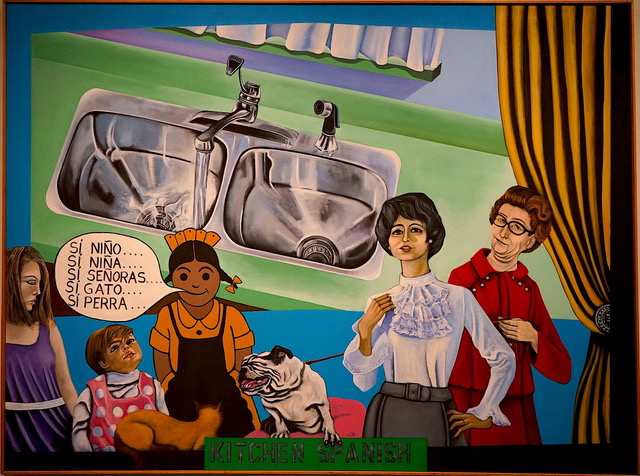Written by Dr. Ricardo Romo
The much anticipated exhibition, “Pop America: 1965-1975” opened this week at the McNay Museum in San Antonio. Art lovers are treated to an exceptional and stunning collection of famous pop artists such as Andy Warhol and Roy Lichtenstein, but also to their contemporaries from Mexico and Latin America. The McNay states that this is “the first exhibition with a hemispheric vision of Pop art.”
Mel Casas, a long time resident of San Antonio and art professor at San Antonio College for nearly 30 years, is one of the featured artists included in the new exhibition. His piece, “Brownies of the Southwest” is one of the few by an American pop artist. His inclusion with other famous American pop artists says much about his art legacy, which many would agree, has not received due recognition. Mel Casas had an interesting art journey and his rise as an important Latino artist merits our review.
As a teen growing up in El Paso during the 1950s, Mel Casas’ interest in painting and drawing grew even though he had few role models. In the mid 1950s he attended Texas Western University in El Paso at a time when few Latinos were pursuing art degrees in Texas or anywhere in America. His desire to connect with his culture and historical past took him to Mexico City where he studied at the University of the Americas. The 1950s were a remarkable time to be in Mexico City. The city had some of the most celebrated murals and paintings in the world due largely to Diego Rivera, Frida Kahlo, Jose Clemente Orozco, and David Alfaro Siqueiros, all icons of Mexican art.
After finishing his studies in Mexico City, Casas returned to his hometown of El Paso where he taught high school for several years. Ironically, Gaspar Enriquez, one of students that he met and mentored at the high school, is the only other Texan in the Pop America exhibit.
Casas is one of the pioneering artists credited with the early creation and subsequent evolution of Chicano art. While creating art and teaching in the early 1970s, he also founded the art group Con Safos. It was during this time that several Chicano artists from South Texas and San Antonio began to think about how their art was different from the art they had studied in college. The group also considered that they needed to give the art they were creating a name since it was in fact a new American art. They chose to call it Chicano Art.
In “Brownies of the Southwest,” Casas found the ideal formula to make a statement that reflected the new Chicano art. In a recent RuizHealy art exhibition catalogue, Carlos Jackson, art history professor at the University of California-Davis, described the painting as touching on “Chicanos’ relations to U.S. culture (eating brownies and participating in the Girl Scouts), Chicano political identity (becoming a Brown Beret), and Chicano historical identity (acknowledging Mexican and indigenous roots)… additionally, the painting relates Chicano art to the wave of U.S. pop art.”
The McNay curators thought so highly of Mel Casas that they added yet another selection of only his work— Mel Casas: Human— which they placed in the downstairs exhibit space. The exhibit includes six of Casas’ famous Humanscape series, of which he made 150. The Humanscape series shows Casas at his best in painting, but also reveals his clever wit and use of satire.
“Kitchen Spanish” is perhaps one of his better known pieces from the Humanscape series. Over the past fifty years we have seen a steady flow of workers from Mexico who come to labor in farms, industries and homes of America. Household workers are especially common in Texas, and Casas did not miss the opportunity to make a social comment about their employment.
In most cases, household workers clean the homes, care for children and cook for non-Spanish-speaking employers. The language barrier is often an issue as most of the recent immigrants are not fluent in English. Thus, the employers attempt to learn a few words in Spanish that will make it possible to communicate what is needed to be done. What makes “Kitchen Spanish” unusual, and perhaps it is Casas’ unique method of satire, is how the words are expressed in Spanish by the housekeeper. Is the housekeeper teaching the family Spanish? It seems so, but the housekeeper must essentially say “Si” (yes) to the children, the ladies who hired her, as well as to the dog and cat. She seems responsible to serve everyone.
“Kitchen Spanish” is a reminder that Texas and many other states rely heavily on Mexican workers, many of whom are undocumented. These workers undertake the unpleasant and dirty work that homeowners prefer not to do. It is a timeless theme about work and who does it, but one that rings ever more true today with the issue of immigration and the proposal to build a border wall. Casas’ six works give us much to think about. Overall his work contributes to our understanding of Latino culture and pressing political issues. It is a show to see.

